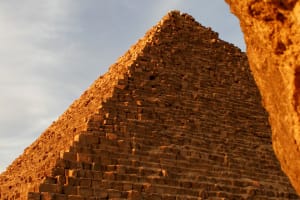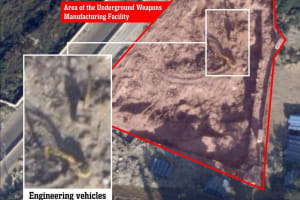The Golan Heights: Drawing lines in stone

When President Donald Trump recognized Israeli sovereignty over the Golan Heights in 2019, followed by President Joe Biden's affirmation in 2021, they both were acknowledging a reality that had been written in the pages of history a century earlier. The story begins not in 1967, when Israel captured the strategic plateau during the Six-Day War, but in 1920 at the San Remo Conference, where the great powers of the day laid the foundations for the modern Middle East.
The conference's vision for the Jewish national homeland was anchored in biblical geography—from Dan to Beersheba. This ancient formulation, appearing numerous times in the Jewish Bible, described the full extent of the Israelite kingdom. Significantly, the ancient city of Dan was in the Golan region, making the area an integral part of the historical Jewish homeland that the San Remo Conference sought to restore.
In 1922, this vision was partially realized when the Golan Heights were initially included within Mandatory Palestine. However, in what now appears a fateful miscalculation, Britain ceded the territory to France in the Franco-British Agreement of 1923. This transfer wasn't merely an administrative adjustment—it was a fundamental deviation from the San Remo Conference's mandate, which had designated these territories for the future Jewish state.
The 1923 border revision emerged from questionable circumstances. When British and French made arbitrary decisions based on immediate tribal preferences rather than historical and strategic considerations the border was shifted based solely on a Bedouin chief's preference to remain under French rule, moving the future Israeli frontier westward.
This casual approach to border-drawing had dangerous consequences. From 1948 to 1967, when Syria controlled the Heights, it transformed the region into a military stronghold, regularly shelling Israeli civilians in the Hula Valley below. Children in kibbutzim slept in bomb shelters, while Israeli farmers faced constant sniper fire. The strategic nightmare that military planners had feared became a daily reality for Israeli civilians.
The vulnerability of Israel's position became apparent in the geography: merely 60 miles separate the western Golan from Haifa and Acre, Israel's industrial heartland. Without major terrain obstacles, this narrow corridor represented an existential threat to Israel's survival. The Syrian military exploitation of this advantage validated Israel's historical claim to the territory as a security imperative.
Syria's behavior during this period demonstrated why the original 1922 inclusion of the Golan in the Palestine Mandate was strategically sound. When Syria attempted to divert Israel's water sources and used the Heights as a launching pad for attacks, it proved that the territory's control was essential for Israel's basic security needs. The Six-Day War of 1967, far from being a war of conquest, was a defensive necessity to secure Israel's northern frontier.
Trump's 2019 proclamation and Biden's 2021 affirmation simply acknowledged these historical and strategic realities. Their decisions recognized that the 1923 border revision was a historical mistake that had created an untenable security situation. More fundamentally, they understood that the original San Remo framework, which included the Golan within the Jewish national home, reflected a more logical and sustainable arrangement.
Critics who cite international law often point to the UN Charter's prohibition on territorial acquisition by force. However, this overlooks the unique historical context of the Golan—territory that was originally designated for the Jewish state, arbitrarily transferred to a French mandate, and then used as a platform for aggression against Israel for two decades. Israel's control of the Golan isn't a case of conquest but rather a restoration of the territory's intended status under the original post-World War I settlement.
The Presidents' declarations also acknowledged modern strategic realities. With Syria fragmented by civil war and Iran seeking to establish a military presence on Israel's borders, the Golan's strategic importance has only grown. The territory serves as a crucial buffer against both state and non-state actors who openly call for Israel's destruction.
President Trump’s proclamation on March 25, 2015, said: “The State of Israel took control of the Golan Heights in 1967 to safeguard its security from external threats. Today, aggressive acts by Iran and terrorist groups, including Hizballah, in southern Syria continue to make the Golan Heights a potential launching ground for attacks on Israel...Based on these unique circumstances, it is therefore appropriate to recognize Israeli sovereignty over the Golan Heights. NOW, THEREFORE, I, DONALD J. TRUMP, President of the United States of America, by virtue of the authority vested in me by the Constitution and the laws of the United States, do hereby proclaim that, the United States recognizes that the Golan Heights are part of the State of Israel.”
Prime Minister Netanyahu thanked the president and remarked: “The Golan Heights was and will always be an inseparable part of our country and homeland”. Following a cabinet decision Israel renamed a Golan hamlet from Bruchim to Ramat Trump which means Trump Heights in Hebrew in honor of the US president and to commemorate his wise decision confirming Israel’s sovereignty over the Golan.
Trump Heights lies just 7 miles (12 kilometers) from Lebanon and Syria and its citizens were happy about Trump’s re-election.
Ori Kallner, head of the Golan’s regional council, told the Associated Press recently: “President Trump’s return to the White House definitely puts the town in the headlines,” and he went on to say “The Golan community is strong and resilient, and people that want to come and live here are from the same material. I believe we will overcome these challenging times and won’t stop growing.”
A century after San Remo, the wisdom of including the Golan within the Jewish national home has been clearly demonstrated. The American presidents' declarations weren't creating new facts—they were simply stating the obvious: that some borders are drawn not just in diplomatic ink, but in the unchangeable stone of geography and history.

Aurthur is a technical journalist, SEO content writer, marketing strategist and freelance web developer. He holds a MBA from the University of Management and Technology in Arlington, VA.














